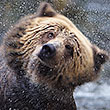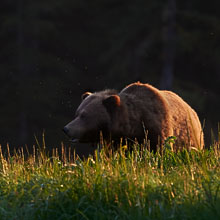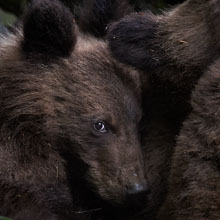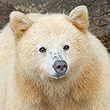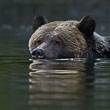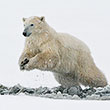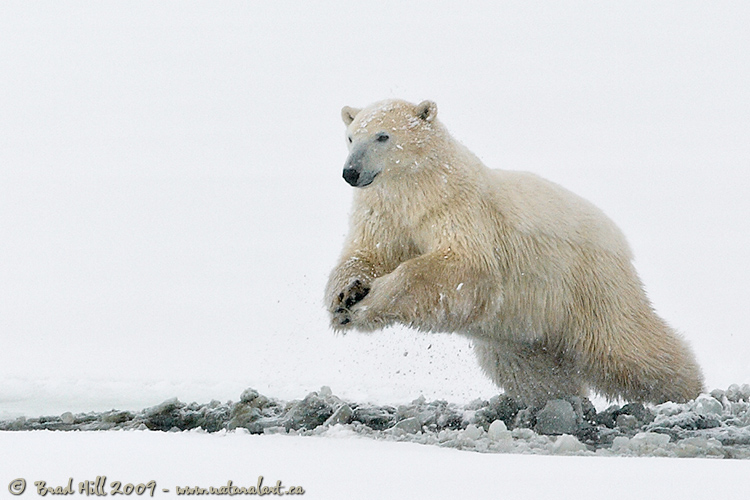
Availability: Undetermined - Enquiries?
In the Field
RAW Power! Cape Churchill, MB, Canada. October 24, 2004.
The absolute muscular power and raw athleticism of wild animals, and particularly carnivores, never ceases to amaze me. The break in the ice that this bear was leaping over was at least 10 feet wide, yet it calmly walked up to it and leapt over as though it were simply stepping over a crack in a sidewalk. And, of course, the bear cleared the freezing water with ease. To the bear, this was no major feat and it really presented no danger at all. To a human, running into this crack in the ice would be both daunting and fraught with danger. It's bit of a sad commentary that we physically inferior beings have used our massive (but short-sighted!) brains to conquer (and threaten the survival of) such impressive creatures in so many ways...
One of the many and most commonly cited reasons for shooting RAW images is that as the RAW processing software improves over time one can go back and re-process old RAW files and produce ever-better images. My reality (and I suspect that of many other photographers) is that I can rarely find time to go back and re-process my older images - I find it challenging enough to keep up with the processing of my current RAW files. Anyway, I originally processed this image back in late autumn of 2004 and immediately relegated it to the "keep it, but don't show it" section of my hard-drive! On a whim I decided to re-process it during the Christmas season of 2009. Well...turns out that the theory of RAW processing software continually improving has real merit - I was able to retrieve FAR more white-on-white detail on the bear and end up with a much, much better image using the latest version of Capture One Pro (V 5.0.1). The image is still no prize winner by any means, but the original was shot under hellish conditions - my lens was fogged over and I even found a not-so-small snow drift in my lens hood when I packed my camera away!
Behind the Camera
RAW Power! Cape Churchill, MB, Canada. October 24, 2004.
Digital Capture; Compressed RAW (NEF) 12-bit format; ISO 200.
Nikon D2H with Nikkor 200-400 mm f/4G ED-IF AF-S VR lens @ 350mm (525 mm EFL) shot from bean bag. VR on and set to "Normal" mode.
1/640s @ f5; +1.0 stop compensation from matrix-metered exposure setting of camera.
At the Computer
RAW Power! Cape Churchill, MB, Canada. October 24, 2004.
RAW Conversion to 16-bit TIFF using Phase One's Capture One Pro 5. Adjustments first-pass/capture sharpening, WB adjustment, exposure adjustment (increase of an additional +0.25 stops), and a strong contrast adjustment (increase).
Further digital corrections on 16-bit TIFF file using Adobe's Photoshop CS4 and Light Craft's LightZone. Photoshop adjustments included major adjustment (increase) of mid-tone contrast, selective saturation adjustment, and selective sharpening for web output. Final tonemapping, balancing and tweaking performed using the Tonemapper/Re-light tool in LightZone.
Conservation
RAW Power! Cape Churchill, MB, Canada. October 24, 2004.
Ten percent of the revenue generated by this image will be donated to the Yellowstone to Yukon Conservation Initiative.
Species Status in Canada*: Special Concern (November 2002).
Polar Bears (Ursus maritimus) are the largest terrestrial carnivores on the planet and the most carnivorous of all bears. They are highly specialized and feed almost exclusively on Ringed Seals. Polar Bears hunt their prey from ice sheets and are dependent upon these ice sheets for their survival.
Like any highly-specialized organism, Polar Bears are highly susceptible to habitat alteration. Climate change - natural or human-induced - is probably the greatest long-term threat to Polar Bear survival. The longer ice-free seasons experienced in the southern reaches of their distribution is already making it difficult for them to hunt.
The Yellowstone to Yukon (Y2Y) Conservation Initiative seeks to ensure that the world-renowned wilderness, wildlife, native plants, and natural processes of the Yellowstone to Yukon region continue to function as an interconnected web of life, capable of supporting all of its natural and human communities, for current and future generations.
For more information on the status of Polar Bears in Canada, go to: http://www.speciesatrisk.gc.ca and search under "Polar Bears".
*as determined by COSEWIC: The Committee on the Status of Endangered Wildlife in Canada


















